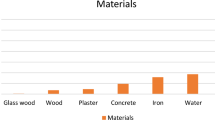Abstract
In order to reduce the energy consumption of building construction and enhance the compatibility and durability of building materials, the application of nanocapsule phase change materials in the construction of civil engineering was studied. The nanocapsule phase change material was prepared by in situ polymerization method, and the mortar with nanocapsule content of 8–23% was developed. It is applied to energy-saving building plaster walls to study the properties of nanocapsule phase change materials and their application effects in the construction of civil engineering. The experimental results show that the emulsification speed and time have certain influence on the particle size of microcapsules; the best mass ratio of core material to wall material is 1:1.4; the wall using the nanocapsule phase change material can raise the temperature by about 2.8°C compared with the ordinary wall, which can effectively reduce the thermal conductivity of the wallboard and make the wallboard have better heat storage capacity. This ensures that the indoor warmth is relatively stable and durable; after the application of nanocapsule phase change materials, the power consumption of the building’s refrigeration system is significantly lower than that of ordinary buildings, and the daily power consumption is reduced by about 16%, which saves electricity and energy consumption in the building.








Similar content being viewed by others
References
Chen YX, Chen YX (2016) Simulation of optimal control of cost and benefit allocation of construction engineering. Computer Simulation 33:208–211
Clement M, Konstantin V, Bukhryakov OB (2016) Ring opening metathesis polymerization of cyclopentene using a ruthenium catalyst confined by a branched polymer architecture. Polym Chem 7:2923–2928
Eunhye S, Se HJ, Min SY (2019) Theoretical study on the stability of insulin within poly-isobutyl cyanoacrylate (PIBCA) nanocapsule. Mol Simul 45:1–8
Fang YB, Qiu ZY (2016) Application of fuzzy self-tuning PID in train air-conditioning control. Automation & Instrumentation 195:82–86
Gu CY, Yang Y, Luo MM (2017a) Combining systemic and intracellular delivery of cytochrome C to tumors by a protein nanocapsule with tumor-specific cleavable PEG. J Biomed Nanotechnol 13:1009–1017
Gu CY, Yang Y, Luo MM (2017b) Combining systemic and intracellular delivery of cytochrome C to tumors by a protein nano capsule with tumor-specific cleavable PEG. J Biomed Nanotechnol 13:1009–1017
Huabin W, Ligang C, Xian CS (2017) Intracellular localization of proteins to specific cellular areas by nanocapsule mediated delivery. J Drug Target 25:1–28
Jiawei L, Karthikeyan K, Kishor TZ (2017) Cool colored coating and phase change materials as complementary cooling strategies for building cooling load reduction in tropics. Appl Energy 190:57–63
Lei W, Liang T, Jing W (2017) Application of phase-change materials in memory taxonomy. Sci Technol Adv Mater 18:406–429
Liu JD, Zhang JC (2016) A potential control strategy for three level three-phase four-bridge Arm of T-Npc. Journal of Power Supply 14:68–73
Lu CX, Li JN, Li X (2016) Study on classification and identification of ionospheric phase pollution. Journal of Chinese Academy of Electronic Science 11:503–509
Luthfi M, Maulu D (2019) The effects of interfacial strength on fractured microcapsule. Front Struct Civ Eng 13:353–363
Mazlan AW, Seyed EH, Hasanen MH (2016) An overview of phase change materials for construction architecture thermal management in hot and dry climate region. Appl Therm Eng 112:1240–1259
Miao Z, Yu D, Bruce C (2016) Symmetry-agnostic coordinated management of the memory hierarchy in multicore systems. ACM Transactions on Architecture and Code Optimization 12:1–26
Paulraj T, Riazanova AV, Svagan AJ (2018) Bioinspired capsules based on nanocellulose, xyloglucan and pectin – the influence of capsule wall composition on permeability properties. Acta Biomater 69:3084–3089
Sahar A, Azam R (2016) Anticorrosion behavior of cyclodextrins/inhibitor nanocapsule-based self-healing coatings. J Coat Technol Res 13:1–8
Shi HD, Li DZ, Gao F (2016) Business model of power consumption and demand side management in energy internet. Chinese Journal of Power Sources 40:2288–2291
Su-Kyung Y, Young-Sun Y, Sang-Jae N (2016) Optimized memory-disk integrated system with DRAM and nonvolatile memory. IEEE Transactions on Multi-Scale Computing Systems 2:83–93
Xue H, Li D (2016) The pricing of the maximum value option in double - fraction jump - diffusion process. Journal of Jilin University (Science Edition) 54:1001–1007
Yalin Z, Yao SQ, Cheng SW (2018) Nanoencapsulated phase change materials with polymer-SiO2 hybrid shell materials: compositions, morphologies, and properties. Energy Convers Manag 164:83–92
Author information
Authors and Affiliations
Corresponding author
Ethics declarations
Conflict of interest
The author declares that he has no competing interests.
Additional information
Responsible Editor: Santanu Banerjee
Rights and permissions
About this article
Cite this article
Yang, T. The application of nanocapsule phase change material in the construction of civil engineering. Arab J Geosci 14, 968 (2021). https://doi.org/10.1007/s12517-021-07296-9
Received:
Accepted:
Published:
DOI: https://doi.org/10.1007/s12517-021-07296-9




